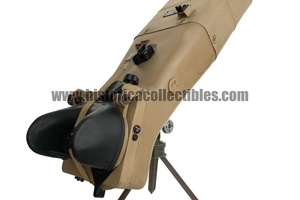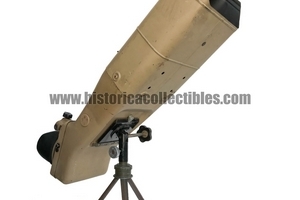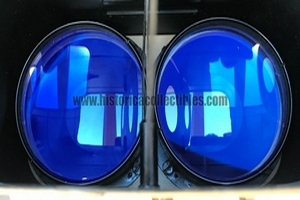Doppelfernrohr D.F. 25x100 "flm" Feinapparate Bau GmbH - Werk Thurn (Carl Zeiss), circa 1944
Doppelfernrohr or Binoculars/Telescope D.F. 25x100 produced in Teplice by "flm" encrypted code name of "Feinapparate Bau GmbH, Werk Thurn" (Czechoslovakia) (at the disposal of Oberkommando der Wehrmacht), a company founded in 1939 by Carl Zeiss Jena and controlled until May 1945.
The first 25x100 binoculars produced were made by Zeiss with the "blc" brand, subsequently starting from 1944 and only until the beginning of 1945, Zeiss moved the production of these telescopes to the Teplice factory in what is now the Czech Republic, producing only 3000 specimens marked in encrypted code "flm". This production is to be considered extremely important as it should have been installed on 6 meter rangefinders, capable of controlling and following the trajectories, even at night, of the weapon that Nazi Germany considered as a decisive turning point for the victory of the Second World War, i.e. the modernized “V1” and the new and deadly “V2” missiles.
After the war the factory was nationalized and some of these binoculars, which were not delivered to the Wehrmacht, were exported to Sweden, others completely disassembled and cosmetically modified to then be sold on the civilian market under the "Somet" brand and later as "Meopta" ( Company which brought together four large Czechoslovakian companies established around 1950); a limited number were acquired by the French Armed Forces as war damage repairs and were never used. In fact, the one in my possession shows a paper document applied, on the front, to its original wooden case which certifies its requisition and for this reason the binoculars are in an excellent state of preservation. Everything works perfectly.
This binoculars/telescope has some unusual and interesting features, such as: The 60° viewing angle. The adjustment of the interpupillary distance occurs by moving a lever under the right eyepiece assembly which rotates the assembly itself eccentrically. The prisms have a system of light-reflecting surfaces to obtain a very bright image even in low light conditions. You can insert two filters (one light gray and one dark) by turning a small knob with "farbgläser" written on it (which means, precisely, colored glass).
There is a rubber mask (which can be raised and lowered) to facilitate and improve vision, thus also facilitating a more comfortable and stable vision. A large knob on the front/top operates and tightens a clamp on the bottom for attachment to the rangefinder. The sun filters can be disengaged by rotating the appropriate lever located above the rain cover.
The eyepieces, of orthoscopic design, are made up of four elements including an aspherical and parabolic lens with the consequence of having a large, clear field of vision. Inside the left eyepiece there is a reticle that can be illuminated via its relative illuminator, which is present, complete with cable for insertion into the battery pack. The large 100 mm lenses, with anti-reflection treatment (a system developed and patented on 1 November 1935 by Aleksander Smakula, a member of the Zeiss staff in Jena since 1934), do the rest and the extremely high light transmission of the binocular gives the possibility of observe the sky at night. In July 1992, the American magazine “Sky&Telescope” published an article on the members of a Czechoslovakian Astronomical Society. This Society discovered 18 comets from 1946 to 1959 using 25x100 binoculars produced in Czechoslovakia by Carl Zeiss Jena, during World War II.






